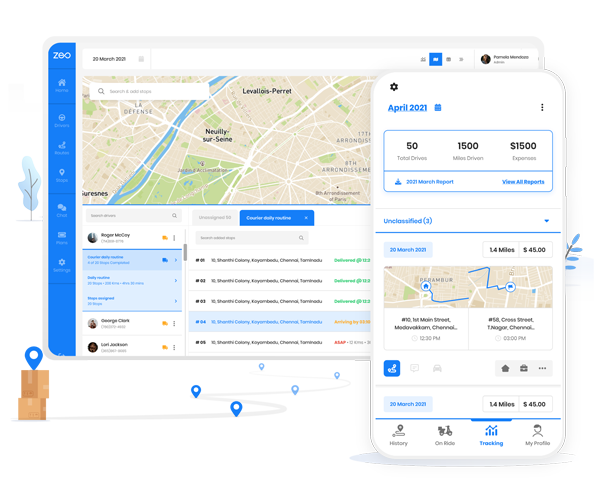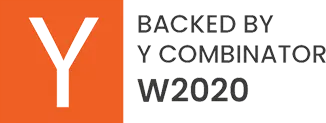Updated on: April 14, 2025
If you are running a food delivery business or a landscaping business or a courier service or providing home healthcare or literally any business that requires you or your staff to visit multiple addresses in a day – chances are that you’ll be looking to solve the vehicle routing problem (VRP)!
Don’t worry! We’ll help you get all the answers about VRP and how to solve it!
What is Vehicle Routing Problem?
In simple words, the Vehicle Routing Problem (VRP) is like solving a puzzle to find the most efficient route to deliver goods or services using a fleet of vehicles. It is an extension of the Travelling Salesman Problem (TSP). The difference is that TSP involves solving for a single route whereas VRP involves solving for multiple routes.
Why is VRP challenging to solve?
VRP is not as straightforward as finding the shortest route.
It gets challenging when you add real-life constraints to it like the capacity of the vehicles, delivery time windows, stop priority status, type of stop (pickup or delivery), and time required at each stop.
Additionally, the higher the number of stops, the more complex VRP becomes as the number of possible route combinations increases.
Why is it important to solve VRP?
- Save costs
Solving VRP has a business impact as it helps in controlling costs. It helps in the optimum utilisation of the resources including the staff and the vehicles. As the fleet follows efficient routes, it helps in reducing fuel and maintenance costs as well.
Read more: How Route Optimization Software Helps You Save Money?
- Improve efficiency & customer experience
With optimized routes, you can make deliveries and client visits faster compared to if the route is not optimized. Quick deliveries increase customer satisfaction. This also means you can make more deliveries/client visits in a day leading to more money in your pocket.
- Reduce carbon footprint
Solving for VRP helps in reducing the environmental impact of your fleet with efficient fuel consumption and lesser emissions. Every effort to save the environment counts.
Types of common VRP
- Capacitated VRP
Capacitated VRP (CVRP) involves calculating the most efficient route considering the capacity of the vehicles. Each vehicle has a limited capacity in terms of the weight and volume it can carry. This problem requires a solution that would maximize capacity utilization at the lowest cost of delivering the goods.
CVRP gets further complicated when the weight and volume of the items to be transported vary. For example, it’s more complicated to solve CVRP for a store selling different types of furniture vs an online store just selling shoes.
- VRP with time windows
To enhance customer experience, your business may allow the customer to select a preferred delivery time window. While it increases convenience for the customer, it creates a challenge for the business to solve VRP with time windows (VRPTW). You have to ensure that the driver reaches each customer as per the time window chosen by them, not sooner or later.
Not adhering to the delivery time window will lead to missed deliveries and added costs of re-delivery. The frustration caused to the customer may also lead to losing further business from them.
- Pickup & delivery problem
Pickup & delivery problem (PDP) involves optimizing a route that includes both pickups as well as deliveries. It’s tricky because the capacity of the delivery vehicle will keep changing at each stop. An example of this can be a garbage truck that picks up garbage and then empties it in the middle of the day before continuing with further pickups.
How to solve Vehicle Routing Problem?
Manual solving
The process of solving VRP manually involves listing down all the addresses, determining the number of vehicles available, adding constraints, and planning a route. However, to find the optimum route, you’ll have to list down all the possible route options by adjusting the order in which addresses are mentioned.
Not only is this extremely time-consuming and complex, but also less flexible in case the delivery addresses differ daily. It’s also not scalable as your business grows and has a high chance of human error.

increase fuel savings
Hassle Free Deliveries & Pickups!
Optimize routes with our algorithm, reducing travel time and costs efficiently.
Get Started for Free
Using Google-OR tools
Google’s OR-tools include the codes required to solve VRP using Python, C++, Java or C#. You can solve it by providing the data regarding the locations, the number of vehicles, start and end locations, capacity constraints, and time windows.
Using Google-OR tools would require you to have knowledge of coding languages or take the help of a developer.
Using route optimization software
A route optimization software enables you to plan efficient routes within seconds. It makes solving VRP easier as you just need to upload the addresses along with the constraints and customer details, provide the start and end location and let the route planner do the hard work for you.
In addition to providing the optimized route, the software also includes helpful features like real-time tracking, direct customer communication, and recording proof of delivery which make your business operations smoother.
Scaling up is not a hassle with route planning software. Zeo route planner allows you to plan a route with up to 2000 addresses!
A route optimization software saves the precious time of your team that can be spent on business development activities.
Hop on a 30-minute demo call or start a free trial to witness the power of Zeo Route Planner!
Conclusion
It’s critical to solve the vehicle routing problem for your business because of its direct impact on the topline and bottomline. While you can try to solve it manually or by using codes, the most effective way to solve it is to leverage the route optimization software at your disposal!

Are you a fleet owner?
Want to manage your drivers and deliveries easily?
Grow your business effortlessly with Zeo Routes Planner – optimize routes and manage multiple drivers with ease.

increase fuel savings
Save $200 on fuel, Monthly!
Optimize routes with our algorithm, reducing travel time and costs efficiently.
Get Started for Free




















